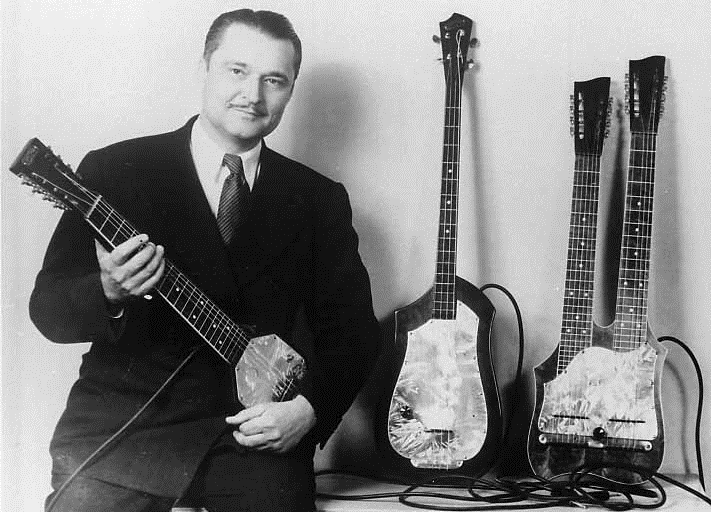Yes, electric guitars did exist in 1937. The first commercially successful electric guitar, the “Frying Pan,” was introduced in 1931.
The electric guitar’s evolution is a fascinating journey, pivotal to modern music. By 1937, the instrument had already begun to capture the imagination of musicians and audiences alike. Inventors like George Beauchamp and Adolph Rickenbacker were instrumental in creating and refining the electric guitar, setting the stage for the rock and roll revolution.
These early models used electromagnetic pickups to convert string vibrations into electrical signals, amplified to produce sound. The electric guitar revolutionized the way music was played and heard, offering a new sonic palette with sustain and volume unlike anything from an acoustic guitar. Artists soon began experimenting with this sound, paving the way for iconic music genres and the birth of countless subcultures.

Credit: europe.yamaha.com
The Birth Of The Electric Guitar
The Birth of the Electric Guitar represents a pivotal point in music history, transforming the soundscape of genres from blues to rock ‘n’ roll. Before the electric guitar’s advent, musicians struggled with projecting the soft tones of the acoustic guitar in band settings, often being drowned out by drums, horns, and other instruments. The pursuit of volume led to some ingenious innovations, culminating in a year that would forever change the stringed instrument’s path: 1937. This was the year when electric guitars began resonating with a broader audience, thanks to breakthroughs in design and technology.
The Early Attempts At Amplifying Guitars
Musicians and inventors alike pursued various methods to amplify the guitar in the early 20th century. Among the initial solutions were resonator guitars, which incorporated metal cones into the body to project sound. However, these still lacked the necessary volume for large venues.
- Resonator guitars used in jazz bands in the 1920s.
- Experimentation with electromagnetic pickups to convert string vibrations into electrical signals.
The Key Players In Electric Guitar Development
A handful of innovators made significant strides in electric guitar development. Players like George Beauchamp and inventors like Adolph Rickenbacker were instrumental in their contributions to the amplification technology.
| Innovator | Contribution |
|---|---|
| George Beauchamp | Co-designed the “Frying Pan,” one of the earliest electric lap steel guitars. |
| Adolph Rickenbacker | Produced and sold Beauchamp’s electric guitar design, leading to wider adoption. |
| Les Paul | Experimental solid-body guitar designs that influenced future electric guitars. |
The Timeline Leading Up To 1937
The journey towards the electric guitar we recognize today stretches back decades. The timeline below highlights the most pivotal moments leading to 1937, the year when electric guitars made a significant impact on the music scene.
- 1890s – Earliest patents filed for telephone transmitters used as pickups.
- 1920s – Resonator guitars offer a louder alternative to traditional acoustic guitars.
- 1931 – The Ro-Pat-In Corporation (later Rickenbacker) introduces the “Frying Pan” electric lap steel guitar.
- 1936 – Gibson releases the ES-150, one of the first electric Spanish-style guitars.
- 1937 – The electric guitar gains popularity, and prominent guitarists begin integrating them into their performances.

Credit: www.craveguitars.co.uk
1937: A Pivotal Year In Electric Guitar History
The year 1937 marked an extraordinary chapter in the annals of music history, etching its name as a benchmark year for electric guitars. It was a time of innovation, an era when musical boundaries were being pushed by technology. The idea of electrifying the guitar was no longer a mere concept but was now a reality, changing the landscape of music forever. In this pivotal year, electric guitars were not just born; they roared to life, capturing the imagination of musicians and audiences alike.
Innovations And Technological Breakthroughs
The late 1930s saw remarkable advancements in guitar amplification. Pioneers in the industry engineered ways to convert string vibrations into electric signals that could then be amplified. This innovation was crucial in pushing the electric guitar to the forefront of the music scene. Let’s delve into the technological milestones that shaped the electric guitar during this pivotal year:
- Pickup technology improved, enhancing sound quality and volume.
- New materials and designs allowed for sustainable note production and reduced feedback, which were significant challenges at that time.
The First Commercially Successful Electric Guitars
Electric guitars may have been conceived before 1937, but this year witnessed the birth of the first commercially successful models. One of the standout innovations was the introduction of the Rickenbacker “Frying Pan”, a lap steel guitar that became the archetype for future designs. As the first electric guitar to gain widespread acceptance, it set the stage for a new musical era.
| Year | Model | Impact |
|---|---|---|
| 1937 | Rickenbacker “Frying Pan” | Catalyst for electric guitar popularity |
Manufacturers like Gibson followed suit, not wanting to be left behind in what was quickly becoming a race for the loudest and most expressive instrument.
Musicians And Performances That Popularized Electric Guitars
Without the musicians who embraced and showcased the electric guitar, the instrument might have remained a novelty. In 1937, artists began integrating this new musical technology into their performances, thrilling audiences with the electric guitar’s versatility and prowess. Notable guitarists of the time included:
- Charlie Christian, who became known for his electrified jazz guitar playing.
- Eddie Durham, a pioneer of the electric guitar in jazz and swing music.
These musicians demonstrated the electric guitar’s potential to the public, thereby cementing its place in the musical pantheon. Their performances proved pivotal in shifting the perception of the instrument from mere curiosity to an indispensable asset for any cutting-edge musician.
The Impact And Legacy Of Early Electric Guitars
The dawn of the electric guitar in the 1930s reshaped the soundscape of music forever, setting the stage for a cultural revolution that would echo throughout the decades. While the instrument’s history dates further back, it was only after 1937 when electric guitars began leaving their indelible mark on the world. The enchanting allure of amplified sound birthed new genres, styles, and icons, cementing its legacy as an indispensable emblem of modern music.
How Electric Guitars Revolutionized Music
Electric guitars introduced an innovation that reshaped the dynamics of musical ensembles. With their ability to sustain notes for longer periods and produce a range of sounds unattainable by acoustic guitars, these instruments quickly became the backbone of many musical acts. Their prominence influenced not only the way music was composed but also how it was consumed – leading to louder concerts, larger venues, and the rise of the lead guitarist as a celebrated figure in popular culture.
- Amplification: Gave musicians the power to fill larger spaces with their performances, allowing for bigger audiences.
- Sound diversity: Enabled a wide variety of tones and special effects that became characteristic of certain music genres.
- Recording: Offered new techniques in the studio, enabling multi-track recording and complex production styles.
Influence On Subsequent Electric Guitar Models
The formative electric guitars of the late 1930s set a benchmark that would inspire countless iterations and improvements. Inventions such as the solid-body guitar reduced feedback and improved sound clarity, giving rise to iconic models that would dominate the industry. Pioneers in the field like Les Paul and Leo Fender drew inspiration from these early models to create instruments that would become synonymous with rock ‘n’ roll and many of its subgenres.
| Year | Model | Impact |
|---|---|---|
| 1950 | Fender Broadcaster | The forefather of the Telecaster, setting a standard for solid-body guitars. |
| 1952 | Gibson Les Paul | Solid-body design complementing the needs of jazz and blues musicians. |
| 1954 | Fender Stratocaster | Introduced contoured body and three pickups, paving the way for sound versatility. |
The Cultural Significance Of Electric Guitars From The 1930s Onwards
The electric guitar quickly transcended its role as a musical instrument, becoming a cultural symbol of rebellion, freedom, and innovation. From the smoky jazz clubs of the 1940s to the rock-and-roll explosion of the 1950s and beyond, electric guitars have been at the heart of cultural movements and have served as the voice for generational shifts in attitude and expression.
- Icon of Rebellion: The electric guitar became a symbol of youth rebellion and counterculture.
- Fashion Statement: Its sleek design and association with famous musicians made it a style icon.
- Technical Development: The ongoing evolution of electric guitar technology mirrors the constant innovation within the music industry.

Credit: jivetimerecords.com
Did Electric Guitars Contribute to the Sound of Bands Like Deftones in the 1990s?
In the 1990s, the unique sound of bands like Deftones was heavily influenced by the use of electric guitars favored by deftones. These instruments, with their distortion and varied tones, allowed for a blend of melodic and heavy riffs, creating a captivating sonic landscape that defined the era’s alternative metal scene.
Frequently Asked Questions Of Did Electric Guitars Exist In 1937
When Did They Start Making Electric Guitars?
Electric guitars emerged in the 1930s. The first commercially successful electric guitar, the “Frying Pan”, debuted in 1931.
What Year Did Electric Guitars Come Out?
Electric guitars were first introduced to the public in 1931. This innovation revolutionized the music industry and shaped modern music.
What Was The Electric Guitar In 1931?
In 1931, the electric guitar was a pioneering instrument, with the Rickenbacker “Frying Pan” being the first successful model. It featured electromagnetic pickups that converted string vibrations into electrical signals.
What Was The Electric Guitar In 1934?
The electric guitar in 1934 was an innovative instrument, featuring electromagnetic pickups to amplify the sound of the strings. Rickenbacker produced the first commercially available model, known as the “Frying Pan. “
Conclusion
Delving into the history of electric guitars has indeed been a fascinating journey. Our quest has confirmed that these iconic instruments graced the music scene as early as 1937, revolutionizing sound and performance. It’s clear that the electric guitar’s legacy began much earlier than some might assume, paving the way for the rock legends of tomorrow.
Keep strumming through history with us for more musical revelations.
